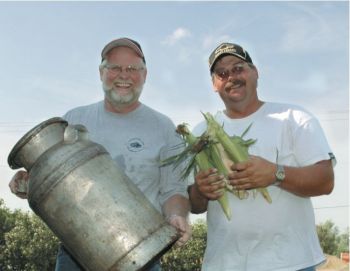The Gift of South Dakota
Subscriptions to South Dakota Magazine make great gifts!
Subscribe today — 1 year (6 issues) is just $29!
Cream Can Cooking
While cookout fans fantasize about the latest in stainless steel grills and wood-fired smokers, a pair of Armour men discovered the secret to a party lies in a vintage cream can. Larry Wilson and Marty Bigge are the kings of cream can cooking in Douglas County. Using just a 10-gallon can and the burner for a turkey fryer, the men can turn a mixture of sausage and vegetables into a hearty meal that feeds 30.
“If you tell somebody you’re ‘having cream can,’ they’re over — right away,” Bigge said, as a crowd gathered one late summer evening to enjoy the last of the season’s fresh sweet corn. “It’s the best thing they ever ate.”
Cream canning is done by filling the 10-gallon can with fresh vegetables including sweet corn and smoked sausage. Water is added and the food is cooked atop an open flame. It has other benefits, in addition to being a taste-tempting meal. “It’s all good for you because it’s all steamed,” Wilson said. He and Bigge host cream can suppers to celebrate everything from a NASCAR race to class reunions or company picnics.
Bigge says that once someone has tasted cream can cooking, the next step is inevitable. “They want cream cans,” he said. Finding a vintage can requires some searching. Wilson acquired his from a brother-in-law, while Bigge purchased his when the local produce company went out of business.
“I think the best place to find a cream can is in a coffee shop, through conversation,” Wilson says. Estate auctions, flea markets and antique stores are also good places to search for cream cans.
Wilson and Bigge said the most important quality for a can is that it has no holes, so it holds water. “And you don’t want a real rusty one,” Bigge added.
While fresh sweet corn is the cornerstone of a good cream can cookout, Wilson and Bigge said they have hosted the suppers throughout the year. “We’ve done it in the winter time, but you’ve got to freeze the corn [during the summer],” Wilson said, admitting that frozen corn does not taste as good as fresh.
The two chefs also have a unique serving dish — a wooden trough lined with tinfoil to hold the steaming hot food from the cream can. “I heard some old-timers talk about how they used to do it,” Wilson said of the trough, which has a one and one-half inch slope and a hole to drain the cooking liquid.
Cream Can Supper
All you need to get started on your own cream can supper is a 10-gallon can and the burner mechanism for a turkey fryer. The vegetables and meat can be customized to please the crowd you’re feeding. Wilson and Bigge usually select an assortment of hearty vegetables and homemade sausage from the meat locker in Delmont. Bratwurst and chicken are also popular choices of experienced cream can cooks. The meal is cooked outdoors since the propane burner has an open flame.
30 ears of fresh sweet corn (or ears that were fresh-frozen during the summer)
30 potatoes, whole
4 large yellow onions, quartered
20 carrots, cut into large pieces
2 heads cabbage, cut into wedges
Any other vegetables such as cauliflower, green pepper or broccoli
8 rings sausage
Water to cover corn
Salt and pepper to taste
Start packing the cream can by standing the ears of corn on end in the bottom of the can. Add water to cover the corn. Some cream can cooks add a bottle or two of beer to the cooking liquid for extra flavor. Salt and pepper may be added to taste; however, if you’re using smoked sausage, the vegetables will absorb the flavor and not a lot of additional seasoning is necessary. Next, layer potatoes, onions, cabbage and other veggies on top of the corn. Wilson and Bigge use mesh bags like those found in the produce department of most grocery stores for the smaller vegetables to ease removal from the can, but tying the vegetables in cheesecloth will also work. Place sausage on top of vegetables, cover the can and light the burner. Total cooking time ranges from 45 minutes to an hour once the water boils and steam starts rising through the can. You will want to check the can after the food has steamed for about 30 minutes to ensure that it does not over-cook.
Editor’s Note: This story is revised from the May/June 2006 issue of South Dakota Magazine. To order a copy or to subscribe, call 800-456-5117.











Comments
We're meateaters here so to the sausage we add ham, turkey legs (browned) and now living in N.M. we even add mutton. Boil, then dump off the water (not on grass, that will kill the lawn instantly) dump into disposable pans, eat up and the pans make great carry out (like there will be anything left over) 25 + years and the cream can feed is still a HUGE hit.